
- MILL HILL & the DOWNS
- WILDLIFE REPORTS 2020

 |
 |
 |
 |
|
|
|
|
|
Noticeable
summer plants of the upper meadows include Greater
Knapweed, Hardheads (=Lesser Knapweed),
Field
Scabious, Meadow Cranesbill, Alexanders,
Pyramidal
Orchids,
Plantains,
Melilots,
Meadow Vetchling, Yarrow,
Eyebrights,
Musk
Thistles,
Hounds-tongue*,
Perforate
St. John's Wort*, Great Mullein*
and
many others. Herb Robert is
found amongst the scrub.
(*notably
on disturbed ground.)
Some Indicator
Plants of Ancient Downland
 |
 |
 |
 |
|
|
|
|
|
Other
indicators on the lower slopes include Dropwort,
Autumn
Ladies Tresses (upper plateau), Hairy
Violet,
all
of which are rarely found on pastures, restored wildlife meadows or agricultural
downland. Other downland plants that are more likely on the biodiverse
down herbland are Wild Thyme,
Carline
Thistle, Dwarf Thistle, Squinancywort,
Fairy
Flax, Small Scabious,
Common
Centaury and
Wild
Basil. There are other more widespread
wild plants like the Mouse-eared Hawkweed,
Rough Hawkbit, Lesser Hawkbit, Bird's Foot Trefoil, Ground
Ivy, Germander
Speedwell, Field Speedwell, Sweet Violet,
Self-heal
and Yellow Wort.
Wild
Flora and Fauna on Chalk flickr
Adur
Wild Flowers 2020
| OVERVIEW:
A large part (724 acres) of the downs including Mill Hill were presented to the people of Shoreham in 1937. Just over 30 acres still remain as public open land and a Local Nature Reserve. This is divided into about 11 acres of grassland and meadows above the ridge, about 9 acres of scrub, the copse and glades at the northern end, and about half of the prime Chalkhill Blue area of 6.4 acres of herbland remaining. 6 acres has been lost to a Sycamore woodland on the southern slopes. This is low fertility chalkland not suitable for grazing. The top area is effectively a wild meadow and the lower slopes a rabbit warren dominated by prostrate (not the upright form) Horseshoe Vetch, Hippocrepis comosa. |

Horseshoe Vetch |
||||||
| Chalkhill Blues:
Mill
Hill is nationally important because of its population of Chalkhill
Blue Butterflies. Estimates of the numbers
are notoriously inaccurate. In the 1950s
the population was estimated by R. M. Craske
to
be 50,000. This may be an exceptionally good year. I would estimate the
numbers at that time to be nearer 25,000 for Mill Hill only. After the
cattle grazing and thorn incursions the numbers plummeted to the most reliable
estimate in 1960
of 6,000. The new road and Sycamore woodland further denuded the Horseshoe
Vetch, Hippocrepis comosa,
and bare chalk downland to a figure I have estimated at a top figure of
3,000 Chalkhill Blue Butterflies at the turn of the millennium (counted
in 2003). Almost
all these butterflies are now to be found on the six acres of the lower
slopes.
|
 |
||||||
| "Our
family lived at The Mill House, Mill Hill, from around 1933
until about 1967, and every July we saw the
"Butterfly Men" walking past onto the Downs. My father used to tell
us that they were interested in the blue butterflies."
Heather
Clark (née Eager), Ryde, Isle of Wight
|
Nearest
Postcode: BN43 5FH
Grid Ref: TQ 21170 07444 (upper car park) Geographic Link OS Map Google Earth Map Magic Map of Mill Hill NR Local Nature Reserve Designation Natural England: Local Nature Reserves Multi-Map (Bird's Eye View) Grid Reference Finder |
FEATURE:
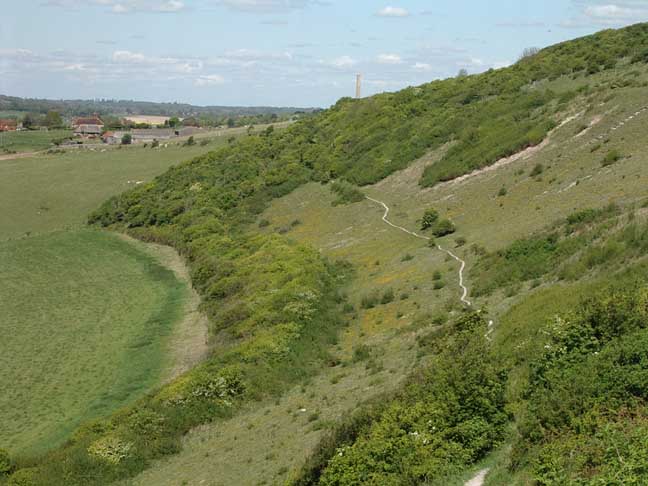
 |
The butterfly lower slopes at Mill Hill are under serious threat by a natural process known as ecological succession where the woody shrubs like Privet, Brambles and Hawthorn invade the herb-rich slopes gradually turning the downs into woodland and eliminating the butterfly larval food plants especially the Horseshoe Vetch, Hippocrepis comosa, on which the Chalkhill Blue Butterflies rely. The remedy is by expert professional removal of the Privet on a regular basis. This job is now being undertaken by volunteers. |

 |

flickr |

|
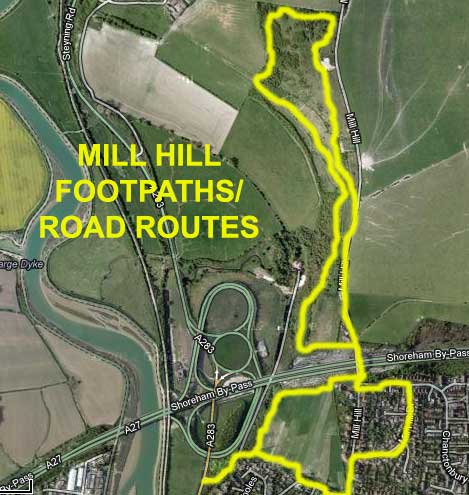 |
OS
Map
Footpaths at Mill Hill |
Mill Hill Wildlife Reports 2021 (Link)
There
were well over a hundred Common Blue Butterflies
on
a sunny Mill Hill. more on the top than the lower slopes. Over 70% were
the bright blue males, with females having a blue tinge and some were mating
in flight. Other butterflies included
occasional Wall Browns, at
least two very
bright yellow and restless Clouded Yellows,
a few Large Whites,
and at least one Meadow Brown.
Devil's
Bit Scabious was in flower
on the lower slopes but it was only an occasional magnet for butterflies
in the early afternoon.
20 September 2020
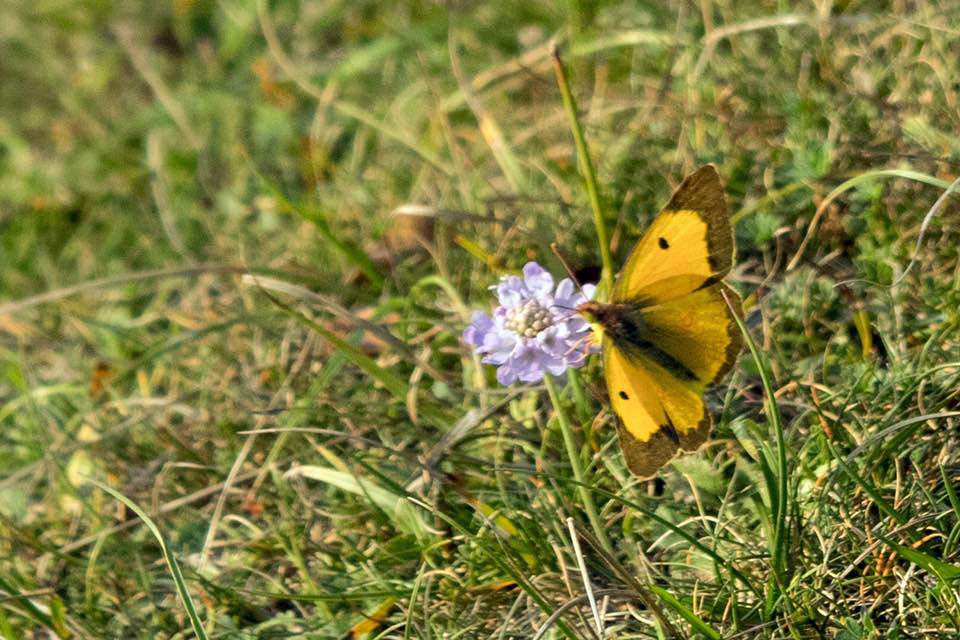
Clouded
Yellow on Mill Hill
Photograph
by Glynis Pierson
15-16
September 2020
Fifteen
species of butterfly were seen on
Mill Hill including several Wall Browns
and a Clouded Yellow.
14 September 2020
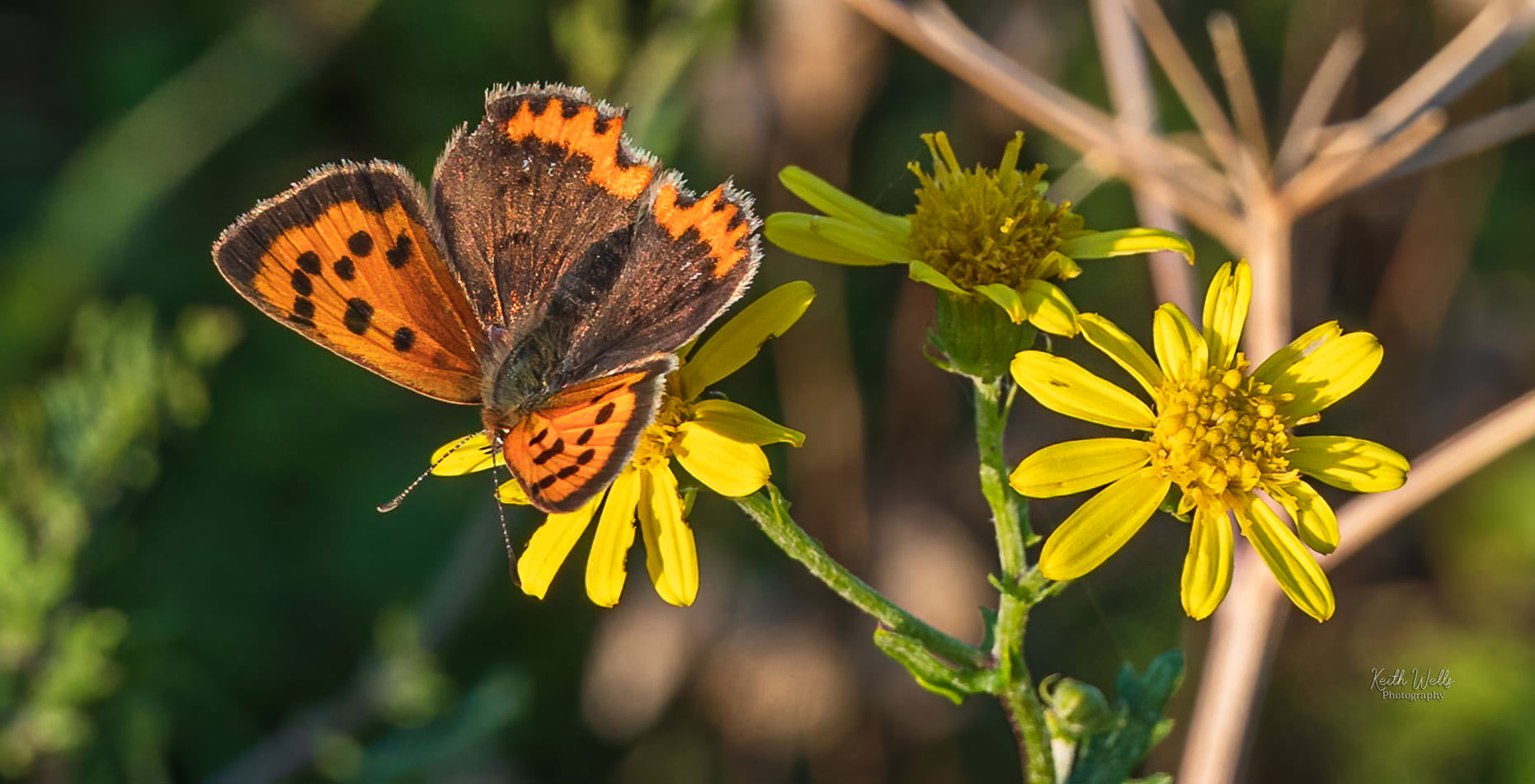
Small
Copper on Hoary Ragwort
Report
& Photograph by Keith
Wells
Adur
Valley & Downs facebook
| 18
August 2020
A
Wasp
Spider, Argiope
bruennichi, was spotted on Mill Hill
in the afternoon.
|
Chalkhill Blues, Hornet Robber Fly
About
a hundred lively butterflies
on the lower slopes of Mill Hill, on a humid afternoon, were led in frequency
by Meadow Browns,
with Chalkhill Blues,
Common
Blues, Adonis Blues, Small Heaths, Large
Whites, and two restless bright Clouded
Yellows. Add on a few Gatekeepers,
one Wall Brown.
two Speckled Woods
and an ambush predator the Hornet Robber
Fly around the winding path and southern
steps. There
were significantly more Meadow Browns,
Common
Blues and Small
Heaths south of the Reservoir.
Adur
Flies
8 August 2020
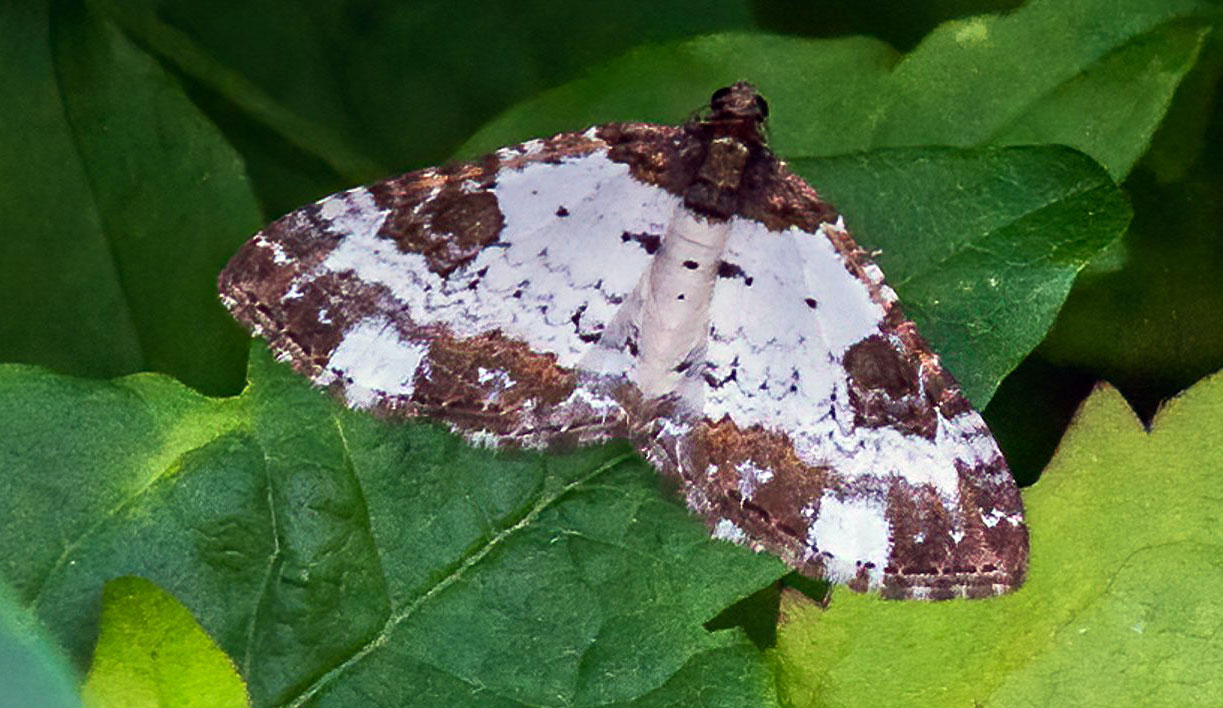
Pretty
Chalk Carpet Moth, Melanthia
procellata
Mill
Hill
Report
& Photograph by Keith
Wells
Adur
Valley & Downs facebook
5 August
2020
There
were at least ten male Chalkhill Blues
fluttering over the southern bank of the Mill
Hill Cutting on a sunny afternoon. There were an estimated forty more
seen on the lower slopes of Mill Hill. The Kestrel
hovered over the Old Erringham pasture.
2 August
2020
With
a breeze blowing the flowers
about there were scores of butterflies
fluttering over MiIl Hill and nearby (in a good year, this would be hundreds)
of nineteen different species: Chalkhill
Blues (estimated
35 males+2),
frequent
Common
Blues,
Painted
Lady, (one at the top of Chanctonbury
Drive), frequent
Gatekeepers,
and occasional Meadow Browns,
a Speckled Wood
in the copse. and a mating pair of Wall
Browns plus one more, male
Adonis
Blues (4), a Red
Admiral and a Peacock
Butterfly. two Holly
Blues in the scrub, a Large
White and
a Small White,
two restless bright Clouded Yellows,
a tatty second brood Dingy Skipper on
the lower slopes, a tatty Small Skipper
and
a Brown
Argus
in the top meadow, a few bright yellow Brimstone
Butterflies, and a Small
Heath on the middle slopes. Six-spotted
Burnet Moths were attracted to purple
flowers, especially Dwarf
Thistle and diminutive Hardheads
(Lesser Knapweed).
A mating pair of Wall Browns
Sloe Berries appeared on the Blackthorn. The green shoots of Carline Thistle appeared on the middle slopes. The first Hawkweed Ox-tongue flowered on the lower slopes.
30 July 2020

Common
Blue Butterflies
Photograph
by Sarah Mitchell
"It was a beautiful, warm evening. We walked, talked, stopped and sat down on the bench taking in the stunning views. We continued with our walk and on the way back to the car park saw a Common Blue Butterfly. This took our interest. Then we saw another, and another, and another. We couldn't believe our eyes as on looking closer there must have been at least a hundred plus butterflies just sitting on the stems of grass and plants sunbathing in the sun."
29 July
2020
Under
a clear blue sky, butterflies
were frequently seen on a hazy afternoon. This was to be expected and nowhere
near a good day. On the top of Mill Hill. amongst the long grasses,
male Common Blues
quickly appeared and one Brown
Argus, frequent Gatekeepers,
and occasional Meadow Browns.
Over the southern steps to the lower slopes there was a Speckled
Wood and a Wall
Brown. The lower slopes were parched with
less nectar flowers than usual. A
restless bright yellow Clouded Yellow Butterfly
was seen after a few minutes. A pair of Brimstones
were fluttering from flower to flower. A Red
Admiral and a Peacock
Butterfly gave a large splash of colour
in contrast to a Large White.
Chalkhill Blue
The
lower slopes also hosted at least thirty male Chalkhill
Blues, occasional Common
Blues,
including
a female, occasional
Meadow
Browns,
including
a mating pair, Gatekeepers amongst
the bushes, one Small Heath, a
faded Small Copper and
a dozen Six-spotted Burnet Moths on
purple flowers. A
few pyralid moths
were spotted the lower slopes of Mill Hill
in the warm sunshine, occasional Pyrausta
purpuralis and Pyrausta
despicata.
24
July 2020
A
Peregrine
Falcon caught
a Starling
over Mill Hill.
Female
Sparrowhawk
hunting over Mill
Hill
Photograph
by Sylvia
Lemoniates
facebook
22
July 2020
On
a warm energy sapping humid afternoon, my
visit to MiIll Hill was not as long as I would have liked. On the southern
part, south of the Reservoir, amongst the parched long grasses,
and all the stages (including the silver discs) of Greater Knapweed,
I disturbed frequent butterflies:
male
Common
Blues (10+), at least one Brown
Argus, frequent Gatekeepers,
occasional Meadow Browns,
one Large White,
at least one Marbled White,
and one Red Admiral.
Fleabane
was in flower. The first Wild
Parsnip appeared.
Brown
Argus, Wayfaring Tree, Common
Blue
Chalkhill
Blue
Down
the southern steps past the Wayfaring Tree
on
to the lower slopes where a "helice" Clouded
Yellow was seen very quickly, but not
for long as it fluttered rapidly between nectar plants, almost exclusively
Wild
Basil. Widespread and frequently seen,
at least thirty male Chalkhill Blues
were very lively, like all the butterflies in the sunshine, including a
few male Adonis Blues,
more male Common Blues, Gatekeepers
and
Meadow Brown
Butterflies, one Brimstone
Butterfly and Six-spotted
Burnet Moths.
Greater
Knapweed, Fleabane, Ploughman's Spikenard
Small
Scabious
Ploughman's Spikenard was seen in flower for the first time this year as well as a diminutive Round-headed Rampion.

Yellowhammer
(male of a pair) on Mill Hill
Photograph
by Tony Gould
on
Mill
Hill Nature Reserve facebook
Kestrel
windhovering on Mill Hill
Photograph
by Sylvia
Lemoniates
facebook
There
was a young Kestrel
with an adult
13
July 2020
At
last, the first Chalkhill
Blue Butterfly of the year was spotted
on the lower slopes of Mill Hill. It was one of a few males seen in the
late afternoon, accompanied by frequent male Gatekeepers,
occasional
Meadow
Browns,
male Adonis Blues and
male Common Blues,
occasional Marbled Whites,
a few Small Whites, one
lively Peacock Butterfly,
one Wall Brown and
a few Six-spotted Burnet Moths. The
Wayfaring
Tree berries had turned red.
Marbled White, Gatekeeper
Chalkhill
Blue
At the top of the southern steps down to the lower slopes a worn Dark Green Fritillary visited flowering Teasel.
Goldfinches
Photograph
by Sylvia
Lemoniates
facebook
Mill
Hill
Rabbit
Photograph
by Sylvia
Lemoniates
facebook
New
Erringham Downs
Summer had just about arrived on a cloudy late afternoon on the lower slopes of Mill Hill, with my first of the year Small Purple-barred Moth, Phytometra viridaria, Shaded Broad-bar and a Six-spotted Burnet Moth, and my first of the year Marbled Whites (3) and Gatekeeper butterflies. I also spotted my first Cinnabar Moth caterpillar on Common Ragwort. Occasionally I disturbed Meadow Brown Butterflies and a Treble-bar Moth. More active fluttering about were a few Large White Butterflies and a brightly coloured Peacock Butterfly. Then to my intense surprise a fluttering bright blue butterfly settled and it was confirmed as a good condition male Adonis Blue. This must be a second brood and it is three weeks earlier than in 2019. There were scores of bright green grasshoppers amongst the short vegetation. Both Great Mullein and Weld were more plentiful than before on the disturbed ground west of and below the winding path. The ground-hugging Dwarf Thistle and Small Scabious were seen in flower for the first time this year. Most of the Deadly Nightshade berries were green but some had turned black. The Wayfaring Tree berries were orange. The Yellow Wort flowers were all closed as it was late in the afternoon.
Vervain,
Marbled
White, Squinancywort
Small
Skipper
As
befitting summer, Greater Knapweed
was flowering on the southern upper
part of Mill Hill, but there were hundreds of heads yet to open. A Red
Admiral settled with its wings closed
out of camera range. Another first of the year was a Small
Skipper in amongst the long grasses.
A Kite-tailed Robberfly, Tolmerus
atricapillus, waited in ambush on the
southern steps. The tiny fruit fly Oxyna
was
seen on Yarrow
for the first time on Mill Hill.
Photo
Gallery
Adur
Flies 2020
21
June 2020
Small
Bird Gallery by Sylvia
Lemoniates
facebook
8 June
2020
Bladder
Campion was very easily seen in large
clumps in the meadow north of the upper car park on Mill Hill. Two
Swifts
swivelled and dived over the middle slopes.
7 June
2020
On
the southern part of Mill Hill, there must have been two hundred Knapweed
Broomrapes and
even more of the smaller Yellow Rattle.
The
first purple flowers
of Greater Knapweed appeared,
seen in the light rain on a cloudy late
afternoon. There were a few small Pyramidal
Orchids seen.
Adur
Orchids
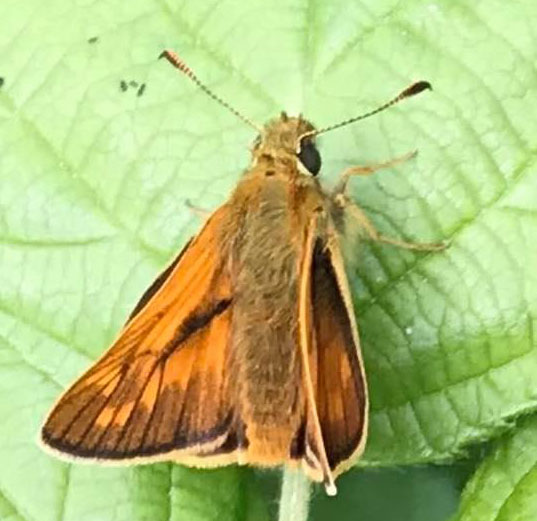 |
2
June 2020
The first Large Skipper of the year was spotted on the middle slopes.
|
1 June
2020
A
first of the year Cinnabar Moth
made a fleeting appearance on the lower slopes of Mill Hill in the middle
of the day. Butterflies
were all lively on a warm sunny day under
a clear blue sky. Small Heaths (20+)
were the most frequently seen but there was also a larger Meadow
Brown
Butterfly. The blue
butterflies were worn at the edges which made
them tricky to identify. I eventually determined that at least a dozen
were male Adonis
Blues
with one female and a few were Common Blues
and one Holly Blue.
Two Brimstone Butterflies
patrolled the steeper slopes. There was a probable Brown
Argus
and
a definite Grizzled Skipper.
Grizzled Skipper on Bramble
The tall Yellow Wort and the ground hugging Wild Thyme were both flowering. More of the diminutive Eyebright and the tall Dropwort graced the lower slopes. Hound's-tongue were going to seed nearby. A few Meadow Cranesbill and the first Greater Knapweed were seen on the southern top part of Mill Hill.
28
May 2020
What
a difference a week makes: the yellow carpets of Horseshoe
Vetch,
Hippocrepis comosa,
on the lower slopes could not be seen from afar, the
flowers
having turned to seed. Under the cloudless
blue sky the Adonis
Blue
Butterflies
(25+)
were frequently seen, the males
were very lively and the females
searching for somewhere to lay their eggs. They equalled in numbers the
other
seven species.
Small
Heaths (16+) were frequent in the sunshine
and both these species could be seen above the ridge as I returned by that
route.
Holly Blues (2+)
fluttered over the hedge north of the bridge and a Speckled
Wood was disturbed over the southern steps
down to the lower slopes. Brimstone Butterflies
patrolled the bottom hedge of the lower slopes where a pair of Dingy
Skippers danced together, and only a few
male Common Blues
and one Brown
Argus.
The most pleasing find of the afternoon was a Burnet
Companion Moth. Grasshopper
nymphs were heard stridulating.
Adur
Butterfly List 2020
Horseshoe Vetch, Hippocrepis comosa
The intrusive Privet, Dogwood and Elderflower were blossoming, but Hawthorn was finished. Yellow Wort and Mouse-eared Hawkweed were seen budding on the lower slopes. A tiny Hairy Violet flower was recognised and there were some more Dropwort flowers.
26 May 2020
Knapweed Broomrape
I made
just a very brief visit to the top southern part of Mill Hill on a demonstration
ebike where I met Philippa
Morrson-Price of the South
Downs National Park Authority. Parasitic plants
were much in evidence: frequent scattered first growths of the very distinctive
Knapweed
Broomrape and the small yellow flowers
of Yellow Rattle.
Wild
Mignonette was seen by the layby.
Sussex
Rare Plant Register
20
May 2020
A
Skylark
sang in the Cirrostratus
sky, on a sunny afternoon that prompted a visit to the top part of Mill
Hill. Frequent
butterflies fluttered
around: occasional male and female Common
Blues,
a few each of male Adonis Blues,
Brimstones,
Dingy
Skippers, my first Green Hairstreak
of the year, and my first Mother Shipton
Moth. A Speckled
Wood showed in the top
copse where I noted hundreds of Garlic
Mustard plants going stringy. Two Holly
Blues fluttered around the top of the
scrub. Bladder Campion
was flowering in the meadow north of the upper car park.
Bladder
Campion, Green Hairstreak
BIrd's
Foot Trefoil
BIrd's
Foot Trefoil joined
Bulbous Buttercups and Horseshoe
Vetch as the yellow
carpets of flowers
on the middle slopes and top plateau. Blackthorn
was in leaf. Hawthorn
flowers were turning brown as the first Elderflower
appeared.
|
|
Adonis Blue Butterflies
Under
a pale blue sky, sheltered from the easterly breeze,
I gave up counting the Adonis Blue
Butterflies over the lower slopes of Mill
HiIl at fifty (46+4).
They were all very lively in the afternoon sunshine and hardly ever settled,
even when mating. After completing the lower
acre transect I spotted an estimated further
twenty, including three mating pairs, as I returned by the winding path.
Again, there were occasional male Common
Blues, occasional Small
Heaths, patrolling
Brimstones, and a handful of faded Dingy
Skippers. I spotted a briefly settled
Small
Copper and a similarly transient Brown
Argus
before
they were chased from their perch by larger blue
butterflies. There was also a Peacock
Butterfly and a Small
White.
Although
past its peak the Horseshoe Vetch,
Hippocrepis
comosa, was resplendent, covering
the steeper slopes.
14
May 2020
My
first two Swallows
of the summer flew low over the middle slopes of Mill HiIl. Cumulus
clouds
cast a shadow over the lower slopes making the appearance of butterflies
very patchy and the estimated numbers not necessarily representative of
presence. Adonis Blues
were
seen frequently and all but one of about twenty were the bright blue males.
Many more were seen when the sun shined through a gap in the clouds as
this caused these butterflies to be active. I had to be careful with recognition
as there was at least eight pristine male Common
Blue Butterflies behaving in a similar
way over the lower slopes. Small Heaths
were also seen and I spotted a resting Small
Copper and a fluttering Brimstone.
Only three Dingy Skippers were
seen over the northern end of the lower slopes. A very small grasshopper
nymph was spotted amongst the short vegetation.
Eyebrights,
Dropwort, Horseshoe Vetch
White
Bryony, Common Blue Butterfly
I visited the middle slopes for the first time this year where there was a few male Common Blues and a few Dingy Skippers amongst the fading Cowslips. A Speckled Wood Butterfly was seen at the corner of my eye as I walked into the top copse. Overall the top of Mill HIll was north-easterly breeze blown and deserted.
Summer was inching in with the first diminutive Eyebrights on the lower slopes where there were a few Bramble and Bittersweet flowers and White Bryony. Flower firsts on the middle part of Mill Hill Nature Reserve included Rough Hawkbit, Dogwood and Yellow Rattle. Bladder Campion was budding.
Mill
Hill from the western towpath of the River
Adur
The
silver flowers are the Hawthorn
Horseshoe Vetch
A sunny visit to Mill Hill in the afternoon was superfluous and nothing new for the year was seen. Horseshoe Vetch, Hippocrepis comosa, was determined to be at its peak, but the flowering was not as luscious as in the best years. Butterflies were frequent but not as varied as earlier. On the lower slopes Dingy Skippers were everywhere and in the half transect, estimated over thirty singles, as well as over ten Adonis Blues, a few male Common Blues, a few Small Heaths, a few probable Large Whites, and a few patrolling Brimstones. Deadly Nightshade was in flower. I returned by the ridge route and added a Wall Brown and another ten Dingy Skippers.
Adonis Blues
Butterflies were frequent and lively on a sunny afternoon, notably the first two female Adonis Blues of the year with half a dozen males, with a pair attempting to copulate. I estimated at least twenty Dingy Skippers all over the lower slopes of Mill Hill . Grizzled Skippers only amounted to a probable pair. Other butterflies were occasional Peacocks, at least five Small Heaths, a few wandering probable Green-veined Whites, a few patrolling Brimstones, a first of the year male Common Blue Butterfly, at least one dark Wall Brown and a handful of Treble-bar Moths.
Dingy Skippers
Draughty
and cloudy, conditions not ideal for butterflies
but better for photography, I nevertheless
enjoyed my afternoon visit to the Horseshoe
Vetch covered lower slopes of Mill HiIl.
Dingy
Skippers were frequent and widespread
and on the two-thirds transect I estimated at least 35, including a mating
pair. However, I did not actually disturb a single
Grizzled
Skipper. Other butterflies disturbed from
rest were occasional Peacocks,
five male Adonis Blues,
my
first pristine Brown
Argus of the year, one Small
Heath, and one
Brimstone. A Treble-bar
Moth showed and a small pyralid
moth
Pyrausta nigrata were spotted.
Adur
Skippers
Adonis Blue
On
the floral front a single Dropwort
was
seen for the first time this year. On the top southern part of Mill Hill
I immediately encountered a Large Red Damselfly,
near the water trough.
Floral
Images
27
April 2020
A
Buzzard
soared over the lower slopes of Mill HiIl, the accompanying Kestrel
looking tiny
in comparison.
A Common Lizard skittered
into shelter after basking on some young Brambles.
Adur
Reptiles 2020
.jpg) |
.jpg) |
|
|
|
A second
day in succession, I visited the lower slopes hoping to get a decent picture
of an Adonis Blue,
but the one sighting was a flutter of blue for just ten seconds. Two Red
Admirals were around the southern steps.
I counted 25 Dingy Skippers
on a half transect but only the occasional Grizzled
Skippers (10+), Brimstones
and Green-veined Whites,
one Small Heath,
one Wall Brown, one
Small
Copper, three Treble-bar
Moths, and three small pyralid
moths
Pyrausta nigrata spotted amongst the
short vegetation on the lower slopes. Another Small
Copper fluttered over the grass at the top
of the southern steps where Silverweed
was flowering.
Adur
Skippers
Adur
Moths 2020
Hound's-tongue,
Weld
(or Dyer's Rocket)
Small
Copper Butterfly
26 April 2020
Dingy Skipper
Typically,
a pristine Wall Brown Butterfly
landed on the winding path through the lower slopes of MiIl Hill, in the
afternoon. It quickly fluttered away. I counted 28 Dingy
Skippers but only the occasional Grizzled
Skippers (8+), Brimstones
and Green-veined Whites,
just the one Small Heath,
and three first of the year very lively male Adonis
Blues on the two-thirds acre transect
walk. A Treble-bar Moth
and a small pyralid
moth
Pyrausta nigrata were spotted amongst
the short vegetation on the lower slopes. A
Red Admiral fluttered over the Stinging
Nettles at the top of the southern steps. Hounds-tongue
was budding on the lower slopes. I also
identified the rosette of leaves of Weld (or Dyer's Rocket),
Reseda
luteola. A Kestrel
flew overhead.
Adur
Skippers
23
April 2020
With
scarcely a cloud in the hazy blue sky, the sunshine made
the butterflies very lively. At the very top of Chanctonbury Drive, two
pairs of sparring Speckled Woods
immediately appeared. Almost simultaneously on the Pixie
Path side of the road to Mill Hill, my first three of the year
Holly
Blues looked brilliant and restless over
the Ivy.
Small Heath
On
the lower slopes of MiIl Hill, in the middle of the day, butterflies
and skippers
were frequently seen and easily disturbed. Once in flight they were extremely
reluctant to settle. Small Heaths
(6+) quickly made a show and seen for the first time this year, with Grizzled
Skippers (12+), first of the year Dingy
Skippers (12+), Peacocks
(6+), occasional Brimstones
and Green-veined Whites,
and a single first of the year Small Copper
on
the half acre transect walk. Common Bee-flies
were frequently seen. A
Crab
Spider Xysticus,
settled amongst the short vegetation. Two more Speckled
Woods were seen over the steps from the south
leading down to the lower slopes.
Adur
Spiders 2020
Adur
Skippers
Welted
Thistle, Wayfaring Tree
Lower
Slopes
Horseshoe Vetch, Hippocrepis comosa, was scattered over the slopes but still only in small patches. I was surprised to see a Welted Thistle on the lower slopes, possibly for the first time ever. Cowslips and Bluebells were flowering south of the Reservoir, but the Daffodils were finished. Blackthorn had receded rapidly down to the last few flowers and was gradually being replaced by the newly flowering Hawthorn. Three large Slow Worms were searched for and found. A Skylark flew overhead and sang.
16 April 2020
Earlier
than usual, the first Horseshoe Vetch,
Hippocrepis
comosa, appeared in flower
on the lower slopes of Mill Hill, It was in the middle below the path,
amongst the grass and Brambles, not where it is usually seen first. A Fox
Spider, Alopecosa, scampered
amongst the short grasses. There was a pair of what were probably Grizzled
Skippers but these were not confirmed
as they did not settle. A Brimstone Butterfly
was on patrol, but it was not warm enough for butterflies.
The first Milkwort
also appeared. Cowslips
were flowering on the southern top part of Mill Hill.
Dandelions
on Mill Hill
Adur
Spiders 2020
9 April 2020
Blackthorn
An
adult
Common Lizard
skitted over the short vegetation on the lower slopes of Mill Hill. On
a hazy sunny very early afternoon, it was shirt sleeves weather
reaching an air temperature of 20°C
at 2:00 pm. Wayfaring
Tree was
flowering by the first bend in the
path after descending
the southern steps to the lower slopes. The
scattered white blossom was the Blackthorn
on
the top and amongst the scrub.
Adur
Thorn
Dog Violets
A Common Bee-fly visited the Dog Violets were scattered over the lower slopes, the land now dried after the recent dry weather. There were a few butterflies; a patrolling Brimstone and a few restless Peacocks.
28
March 2020
|
VISITS TO MILL HILL BY MOTOR VEHICLE ARE PROHIBITED The upper car park is closed |
23 March 2020
Sweet Violets
Sweet
Violets were
scattered over the lower slopes of Mill Hill, the land now dried after
the weekend sunshine. Even the steps at the southern end were no longer
muddy, where I immediately spotted a Brimstone
Butterfly
fluttering around. In
the very early afternoon a Peacock
Butterfly flew energetically over the
slopes below the path. On the southern top part of Mill Hill I found the
same Adder as
before but this was the only reptile.
The main stands of Blackthorn
were not yet blossoming, but there was
one tree in full blossom at the top of the wooded slope. (The
sepals were inspected to confirm the ID.)
Adur
Thorn
Adur
Violets
16
March 2020
After
five months isolation from Mill Hill
because of inclement weather, the sun
finally came out on the muddy southern top part of Mill
Hill Nature Reserve. And
with the sun came my first butterflies
of the year: at least two strong-flying Brimstone
Butterflies skirting the still bare scrub,
and secondly a Peacock Butterfly
first spotted on a drain cover south of the Reservoir. I was most pleased
to spot two Small Tortoiseshells
fluttering over the thoroughly mown meadow (a good job) north of the upper
car park.
Adder,
Common
LIzard
Slow
Worm
Two
large Slow Worms,
a small slim Adder
and
a Common LIzard were
all firsts of the year reptiles
amongst some old logs deliberately placed on the southern part of Mill
Hill. Small birds
sang to each other from deep inside the bushes but they were mostly too
well hidden for me to identify, although I recognised a pair of Blue
Tits. A male Pheasant
was not so easy to spot into the low light of the early afternoon. Clumps
of Daffodils
flowered on the southern part of Mill Hill. Green
Alkanet was also seen in flower
south of the Reservoir. In the top copse,
the first flowers and leaves were seen amongst the budding Blackthorn.
Adur
Thorn
12 March 2020
Adder
on
Mill Hill
Report
& Photograph by Sean
Stones
Autumn mowing at the top of Mill Hill meant that the grass was very short and this Adder moving around was easier to spot than it might otherwise have been.
DOGS
Bringing into, or permitting
to remain within the Reserve, any dog, unless it is kept on a lead or effectively
restrained from worrying or disturbing any animal or bird or from entering
any water trough
Mill
Hill Wildlife Reports 2018 (Link)
Mill
Hill Wildlife Reports 2017 (Link)
Mill
Hill Wildlife Reports 2016 (Link)
Mill
Hill Wildlife Reports 2015 (Link)
Mill
Hill Wildlife Reports 2014 (Link)
Mill
Hill Wildlife Reports 2013 (Link)
Mill
Hill Wildlife Reports 2012 (Link)
Mill
Hill Wildlife Reports 2011 (Link)
Identification
of Grasses (Link)
Mill
Hill Grasses
 |
A
Nature
Reserve is defined in Section 15 of
the National Parks and Access to the Countryside Act 1949,
as land managed for the purpose:
(a)
of providing, under suitable conditions and control, special opportunities
for the study of, and research into, matters relating to the flora and
fauna of Great Britain and the physical conditions in which they live,
and for the study of geological and physiographical features of special
interest in the area; or
|
17+
SPECIES OF BUTTERFLIES DEPENDENT ON MILL HILL
FOR BREEDING:
(Estimated
numbers for Mill Hill Nature Reserve only
are in brackets)
| Chalkhill
Blue (3000 +)
Adonis Blue (50 -100) Dingy Skipper (75) |
Small
Heath (250)
Wall Brown (12) Meadow Brown (300) |
Marbled White (50)
Gatekeeper (200) Speckled Wood (>50) Green-veined White (2+) |
Common
Blue (>4000+)
Small Blue (5) Brimstone (8) |
Small
Skipper (>50)
Large Skipper (10+) Grizzled Skipper (20) Brown Argus (>30) Green Hairstreak ( a few) |
The other species may breed on Mill Hill, but there main breeding area will be adjoining fields or slightly further away. e.g. Small Blue (included above), Small Copper, Small Tortoiseshell, Green-veined White, Peacock, Ringlet, Small White, Large White, Comma, Holly Blue, Orange Tip. (=10). There are huge variances each year for most species.
The following are immigrants &/or hibernators: Red Admiral, Painted Lady, Clouded Yellow.
The following have not been positively identified (because of ID difficulties): Essex Skipper. This species is now included for a local field on the Adur Levels within 500 metres of Mill Hill.
(=30)
The
following was confirmed only in 2009:
Green
Hairstreak.
(=31)
The
following was confirmed only in 2014: Dark
Green Fritillary
(=32)
The next one is no longer
found on Mill Hill but were there in the distant (1947) past: Grayling.
The next one has been recorded
near Mill Hill in the middle distance past: White-letter
Hairstreak
(=34)
The
Silver-spotted
Skipper does not appear to ever have occurred
on Mill Hill. PS: There have been recent records.
The
Silver-studded
Blue has never been recorded from Mill Hill
The Short-tailed Blue was recorded as a single immigrant in 1956.
17
August 2009
A
possible (unconfirmed) Brown Hairstreak Butterfly
was
spotted. A confirmed one was spotted nearby.
2017
Brown
Hairstreak and Silver-spotted
Skipper have been confirmed from Mill
Hill. The first is notoriously difficult to spot and was probably already
there. The skipper
may be a new addition, but it is small and not easy to spot, and there
have now been numerous sightings
Aerial
Map
Lower
Adur Levels (MultiMap) including Lancing Clump and Mill Hill
Horseshoe
Vetch, Hippocrepis comosa
First
Draft of the Article for the Shoreham Society Newsletter